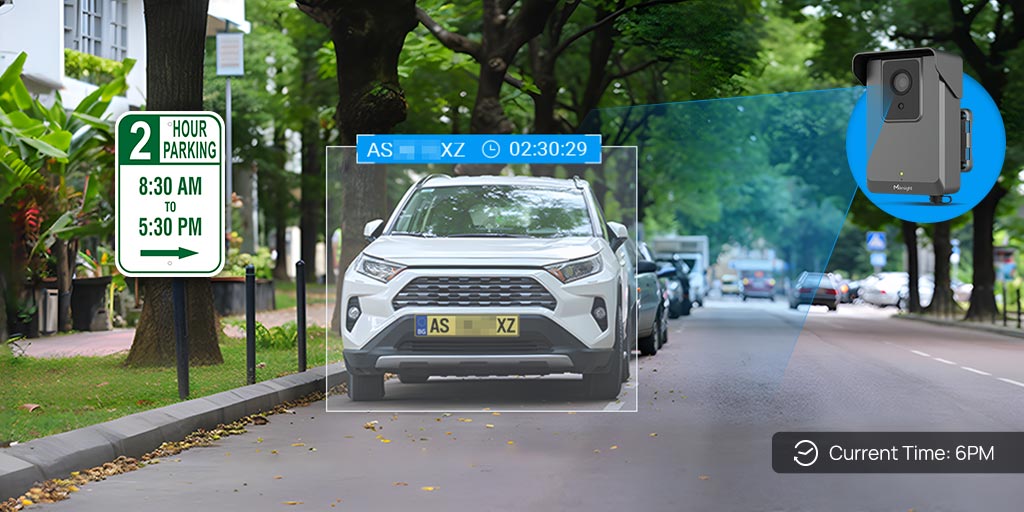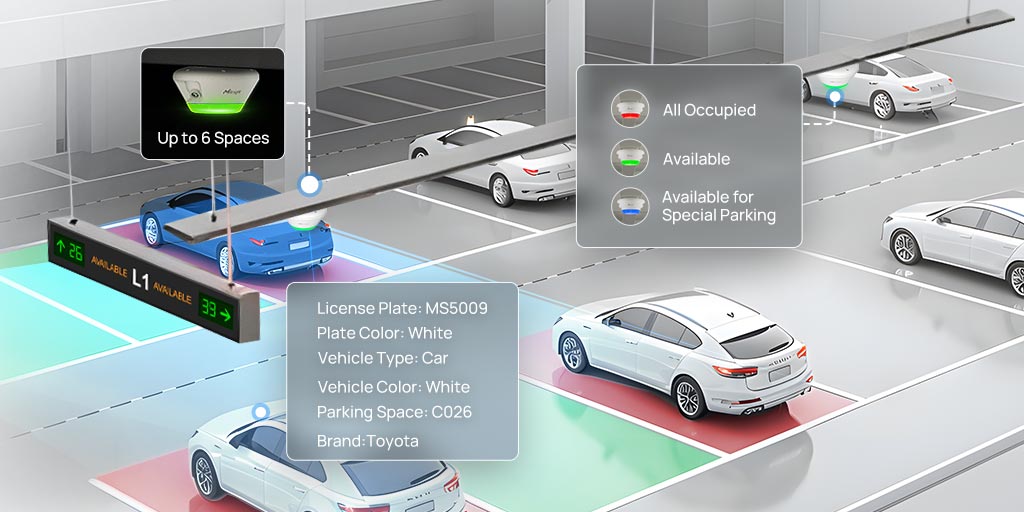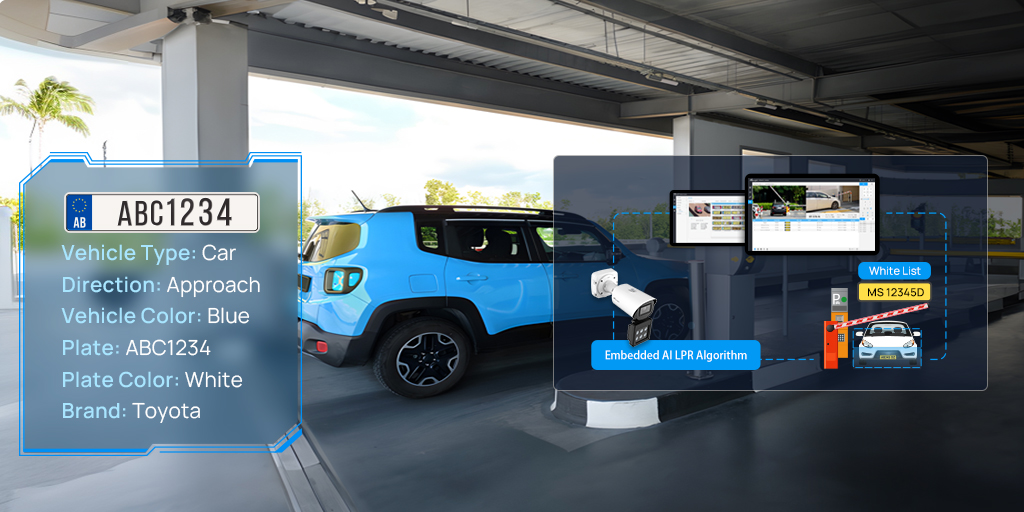Why LPR Cameras Are Essential for Modern Parking Solutions:
Accuracy, Security, and Efficiency

- Home
- LPR Cameras
- LPR Cameras for Modern Parking Solutions
Traditional parking management often struggles with inefficiencies, security risks, and manual enforcement challenges. From unauthorized parking and inaccurate time tracking to labor-intensive operations, conventional methods fall short in meeting the demands of modern urban mobility. License Plate Recognition (LPR) technology has emerged as a transformative solution for both parking management and enforcement, enabling automated vehicle identification, streamlined operations, and enhanced security.
This blog explores the essential role of LPR cameras in modern parking solutions. It covers how LPR-enabled cameras work, the key benefits they offer, common application scenarios, and real-world success stories. It also highlights how Milesight's advanced LPR solutions can transform parking operations and why partnering with Milesight is a smart choice for future-ready parking management.
How LPR-Enabled Parking Cameras Work in Car Parks?
1. Enhancing Parking Operations with LPR Technology
License Plate Recognition (LPR) technology optimizes parking management by enabling real-time vehicle identification. Integrated into parking cameras, LPR improves security, access control, automated payment, and enforcement, reducing manual work.
LPR enhances security by logging every vehicle’s entry and exit, aiding incident investigations. For access control, it enables automatic gate opening for authorized vehicles, easing congestion. For automated payment, it supports cashless, ticketless payments by linking plate data to payment systems. For enforcement, LPR detects unauthorized or overstaying vehicles, triggering alerts or fines automatically.
This automation reduces errors, cuts labor costs, and improves the parking experience for operators and users.
2. How LPR Cameras Recognize License Plates
LPR cameras use a multi-step process to identify vehicle license plates quickly and accurately:
- Plate localization: Identifies the plate area in the vehicle image and corrects angles or distortions.
- Normalization: Enhances images by adjusting contrast, reducing glare, and merging multiple frames to reduce blur.
- Character segmentation: Separates individual license plate numbers and letters, even with irregular fonts or spacing.
- Optical Character Recognition (OCR): Converts characters to text, using validation rules to improve accuracy.
This process ensures reliable, real-time recognition in various parking conditions.
3. Seamless Integration with Parking Management Systems
LPR cameras integrate smoothly with Parking Management Systems (PMS) to create unified, ticketless, and cashless parking solutions. Real-time data updates enable automated gate control, occupancy tracking, and accurate duration calculation.
Integration with third-party platforms further enhances functionality, supporting pre-booking, VIP/blacklist recognition, subscription access, and dynamic pricing through open protocols and SDKs.
By combining real-time vehicle data with flexible system connectivity, operators gain greater scalability, improved data visibility, and smarter, more efficient parking management.
Exploring the Diverse Scenarios of LPR in Parking Environments
LPR technology plays a key role in smart city and community development, enabling efficient, automated parking management across diverse environments. From on-street and indoor facilities to outdoor lots and access control points, LPR enhances regulation, user experience, and operational efficiency.
1. On-Street Parking Solution
Typical Scenarios:
- City roads
- Low-emission zones
- EV charging stations
- Business districts
On-street parking environments demand real-time monitoring, flexible deployment, and efficient enforcement. In areas such as low-emission zones, accurate license plate data enables automatic identification of high-emission vehicles, supporting regulatory compliance. At EV charging stations, parking duration can be monitored to prevent overstays and ensure space turnover.
Solar LPR cameras are ideal for on-street parking scenarios, where power and network access may be limited. Their cable-free installation and wireless connectivity enable flexible deployment across city roads and curbside areas, while real-time license plate recognition ensures efficient enforcement and improved compliance.
Milesight Solution:
4G Solar-powered Traffic Sensing Camera
AI & Radar-triggered Vehicle Capture for Parking Event Detection
Key Values Delivered:
- Enables smart regulation enforcement by accurately identifying unauthorized or misused parking
- Reduces deployment and maintenance costs with solar-powered, wireless design
- Extends enforcement reach to remote or infrastructure-limited areas
- Improves operational efficiency by automating violation detection and reporting
- Enhances traffic flow and sustainability by ensuring proper usage of EV and low-emission zones
2. Indoor Parking Solution
Typical Scenarios:
- Shopping malls
- Office buildings
- Hospitals
- Airports
Indoor parking facilities often face challenges such as limited lighting, high traffic volume, and the need for streamlined vehicle tracking. These environments require precise space management and real-time vehicle identification. In locations like shopping malls or airports, providing a fast, intuitive, and user-friendly parking experience is critical.
Milesight Solution:
Indoor Parking Guidance Camera
AI-powered Parking Space Occupancy Detection with ≥99.9% accuracy
Key Values Delivered:
- Maximizes space utilization by accurately detecting vehicle presence in real time
- Improves user experience with visual guidance and seamless navigation
- Reduces congestion and wait times with automated entry/exit handling
- Supports intelligent, ticketless payments by linking vehicle data to parking systems
- Minimizes deployment complexity and costs with simplified installation and integration
3. Outdoor Parking Solution
Typical Scenarios:
- Open-air parking lots
- Stadiums and exhibition centers
- Residential communities
- Transit hubs and public facilities
Outdoor parking environments are subject to varying lighting and weather conditions, large vehicle volumes, and the need for wide-area monitoring. Facilities must ensure high-accuracy detection across many parking spaces while maintaining operational stability and resilience.
Milesight Solution:
Outdoor Parking Management Camera
Support Occupancy Detection Up to 100 Parking Spaces
Key Values Delivered:
- Delivers high-accuracy monitoring across large open areas
- Minimizes false detection and misreads even in challenging lighting
- Supports flexible deployment in varied outdoor layouts
- Enables centralized management through seamless platform integration
- Enhances ROI with durable design and scalable performance
4. Vehicle Entrance & Exit Management
Typical Scenarios:
- Residential communities
- Corporate campuses
- Parking booths and toll gates
- Logistics zones and restricted access areas
Accurate and automated gate control is crucial for improving vehicle flow, enhancing security, and maintaining parking order. Given the rapid lighting changes at entrances and exits, LPR cameras with WDR and integrated IR or white light illumination are essential to ensure consistent plate recognition performance.
Milesight Solution:
Entrance & Exit Supplement Light Camera
Integrated Supplement Light + Wiegand Protocol for Precise Access Control
Key Values Delivered:
- Automates access control with reliable license plate recognition
- Improves traffic efficiency by enabling fast, hands-free vehicle entering and exiting
- Enhances security with real-time alerts for unauthorized or unknown vehicles
- Supports dispute resolution through multi-angle evidence capture
- Integrates easily with existing gate, payment, or security systems
Practical Applications of LPR Cameras for Parking: Case Studies from the Real World
Case 1: Off-Grid Smart Parking Solution in Hong Kong
To modernize the parking experience in Hong Kong’s public housing estates, Milesight deployed a smart, off-grid vehicle detection and license plate recognition system. The project required a solution that could operate without traditional infrastructure while maintaining high accuracy and seamless integration with the client's backend system. Milesight’s 4G Solar-powered Series Camera delivered a flexible, solar-friendly solution tailored to Hong Kong’s unique traffic and regulatory context.
Case 2: Smart Customized Plate Size Recognition in Spain
In a large logistics hub in Spain, Milesight's Entrance & Exit AI LPR Pro Dome Cameras were deployed to monitor vehicle activity in the loading zone. Each camera covers two parking spaces on the loading platforms where trucks load and unload goods. The primary goal was to accurately capture license plate information of vehicles actively involved in loading operations, ensuring efficient logistics management and traceability.
Benefits for LPR Parking Solutions
License Plate Recognition (LPR) technology has become a cornerstone of modern parking systems and the parking industry, offering a wide range of benefits that elevate the security, efficiency, and overall experience of parking operations. Below are some of the key advantages:
1. Enhance Parking Lot Security
LPR-enabled parking cameras provide real-time vehicle identification and detailed entry/exit records, significantly strengthening parking lot security. Every vehicle is automatically logged with time-stamped images, enabling quick incident tracing and effective surveillance. By identifying unauthorized or blacklisted vehicles instantly, the system helps prevent theft, vandalism, and illegal access.
2. Increase Operational Efficiency
Automated license plate recognition removes the need for manual ticketing and staff at entry/exit points, lowering labor costs and reducing errors. LPR systems also provide real-time parking space monitoring, enabling dynamic space management and faster vehicle flow. This increases turnover rates, allowing more vehicles to use the same spaces and boosting revenue. Automated reporting further helps operators optimize pricing, capacity, and staffing decisions for greater efficiency.
3. Optimize Users' Parking Experiences with LPR-Based Ticketless Parking
LPR technology delivers a seamless, ticketless, and cashless parking experience by automatically recognizing license plates at both entry and exit points, eliminating the need for physical tickets, RFID tags, or any physical interaction, making parking faster, safer, and more convenient - especially in high-traffic locations such as malls, offices, airports, and event venues.
With ticketless parking, vehicles can pass through gates without stopping, significantly reducing queues and eliminating issues like lost tickets or manual checks. For pre-registered or returning users, entry and exit are nearly instantaneous. In Free Flow Parking systems, this process can take less than a second, while even gated systems typically complete vehicle recognition and access within just a few seconds.
Beyond convenience, this contactless experience meets modern health and safety expectations and supports a fully digitalized parking operation, contributing to smoother traffic flow, reduced emissions, and enhanced user satisfaction.
4. Speed Up the Parking Enforcement Process
LPR cameras automate the detection of violations such as overstays, unauthorized access, and expired permits by matching plate data with timestamps. Alerts are triggered automatically for enforcement staff, eliminating manual patrols. The system can also issue digital tickets with photographic evidence, saving time and ensuring accuracy. Real-time monitoring enables faster response to reserved spot misuse or dynamic pricing enforcement, improving compliance while reducing costs and enhancing efficiency.
Why Partner with Milesight
Seamlessly Integrating Milesight's LPR Cameras into a Unified Parking Ecosystem
Milesight's LPR cameras are equipped with advanced edge processing capabilities, enabling them to perform license plate recognition, vehicle classification, and rule-based event detection directly on the device. This reduces system complexity and ensures fast, accurate operation even without constant server-side support.
Built with interoperability in mind, Milesight cameras also support standard protocols such as ONVIF, CGI, and HTTP/HTTPS APIs. This makes them highly compatible with a wide range of third-party parking management platforms like Zatpark, Plate Recognizer, and other cloud or on-premise systems. Their openness allows seamless integration into existing infrastructures, supporting applications from automated access control to real-time enforcement and payment solutions.
This interoperability allows operators to streamline workflows - from license plate detection to ticket issuance - within their existing platforms. For example, data captured by Milesight cameras can be instantly pushed to Zatpark's backend for permit verification, overstay monitoring, or issuing PCNs (Penalty Charge Notices), ensuring accurate and efficient operations.
With both intelligent edge functionality and powerful integration flexibility, Milesight offers a future-proof solution for building efficient, scalable, and smart parking ecosystems.

Conclusion
In today's rapidly evolving urban landscape, traditional parking methods no longer meet the demands of efficiency, security, and user convenience. LPR cameras have proven to be an essential component of modern parking solutions by delivering unparalleled accuracy in vehicle identification, enhancing security through real-time monitoring, and significantly boosting operational efficiency. From automated access control and cashless payments to dynamic enforcement and seamless integration with parking management systems, LPR technology revolutionizes how parking facilities operate and serve their users.
With advanced solutions like those from Milesight, parking operators can future-proof their infrastructure, improve user satisfaction, and optimize resource utilization. Ultimately, embracing LPR cameras is not just an upgrade - it is a fundamental step towards smarter, safer, and more efficient parking management.
Frequently Asked Questions
Where should LPR parking cameras be installed for optimal license‑plate capture?
LPR cameras should be deployed at controlled vehicle ingress and egress points where vehicles decelerate, such as entry/exit gates, toll booths, or barrier arms. Optimal placement ensures an unobstructed field of view focused on the license plate zone, minimizing occlusions caused by vehicle components or infrastructure elements. Positioning near stop lines or speed bumps is recommended to reduce vehicle speed and improve capture accuracy.
What mounting height and tilt angle are recommended for parking deployments?
Recommended mounting height ranges between 2 to 6 meters above ground level. The tilt angle relative to the horizontal plane and the license plate plane should not exceed 30°, to prevent perspective distortion and ensure plate characters are captured at optimal resolution. Both horizontal and vertical alignment are critical for maximizing OCR accuracy and minimizing motion blur.
How many parking spaces can a single camera monitor?
The monitored parking space count depends on camera resolution and algorithm capability. Typical AI-powered indoor parking guidance cameras cover up to 6 spaces per device, whereas outdoor parking management cameras using occupancy detection algorithms can monitor up to 100 spaces. For LPR-specific recognition, cameras generally focus on narrow zones - up to 4 spaces - to guarantee >98% recognition accuracy.
Can parking lot cameras support license plate recognition and space detection simultaneously?
Yes. Advanced LPR cameras integrate multi-modal AI algorithms, enabling concurrent license plate recognition and parking occupancy detection. Dual-lens architectures capture both vehicle identification data and spatial occupancy metrics in real-time, facilitating unified enforcement and space management workflows within a single device.
What are the pros and cons of sensor-based vs. camera-based parking solutions?
Sensor-based systems (e.g., inductive loops, ultrasonic, infrared) offer high reliability in single-spot occupancy detection with minimal environmental sensitivity but require invasive installation and provide limited vehicle identification capabilities.
Camera-based systems leverage AI-driven analytics to deliver license plate recognition, vehicle classification, and wide-area coverage. They enable multifunctional use cases, including security and enforcement, but depend on lighting conditions and require higher upfront hardware and processing resources.
Is API integration with third-party platforms supported?
Yes. Modern LPR cameras support open APIs, SDKs, and standard communication protocols (ONVIF, CGI, HTTP/HTTPS), enabling seamless integration with third-party Parking Management Systems (PMS), Access Control Systems, and cloud platforms. This interoperability supports automated data exchange for permit validation, dynamic pricing, violation processing, and centralized monitoring, facilitating scalable and modular parking infrastructure deployments. Milesight LPR cameras also fully support these integration capabilities, ensuring smooth compatibility with diverse platforms and systems.
Milesight Related Products
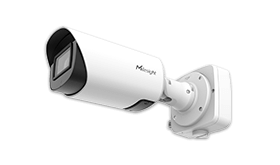
AI Outdoor Parking Management Pro Bullet Plus Camera
1 Camera, 2 Parking Detection Modes
Explore More
Entrance & Exit AI LPR Pro Bullet Plus Camera
Smart & Ruggedized Camera for LPR Solution
Explore More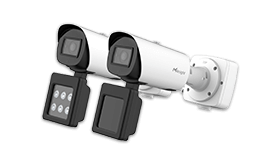
Entrance & Exit Supplement Light AI LPR Pro Bullet Plus Camera
Integrated Supplement Light & Wiegand Protocol Supported
Explore More
